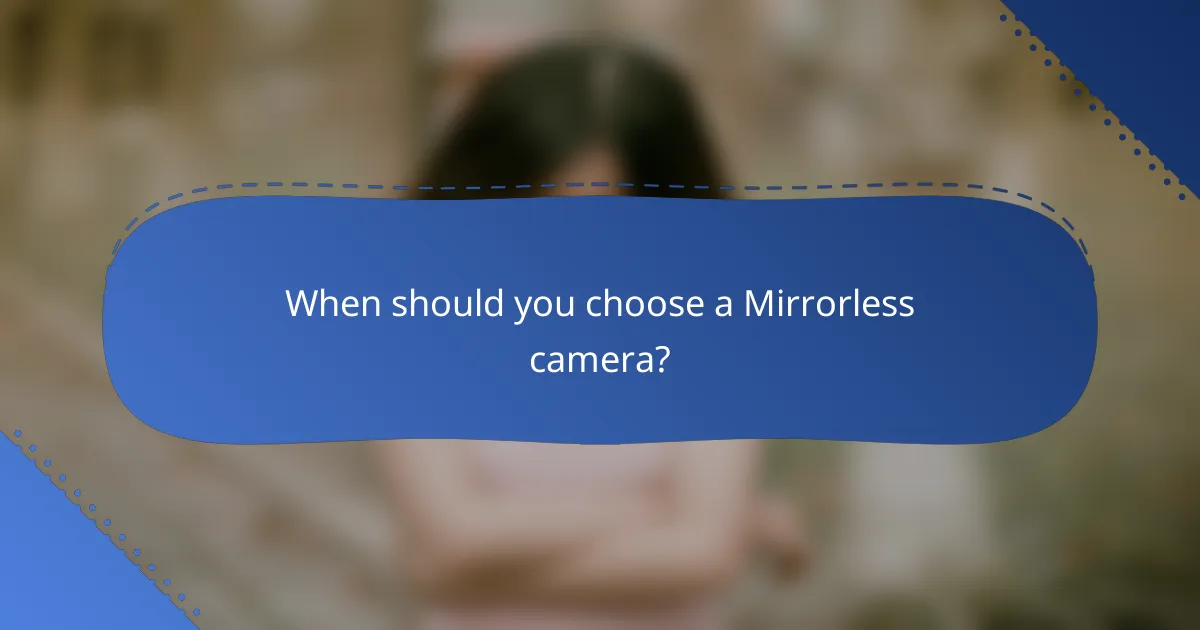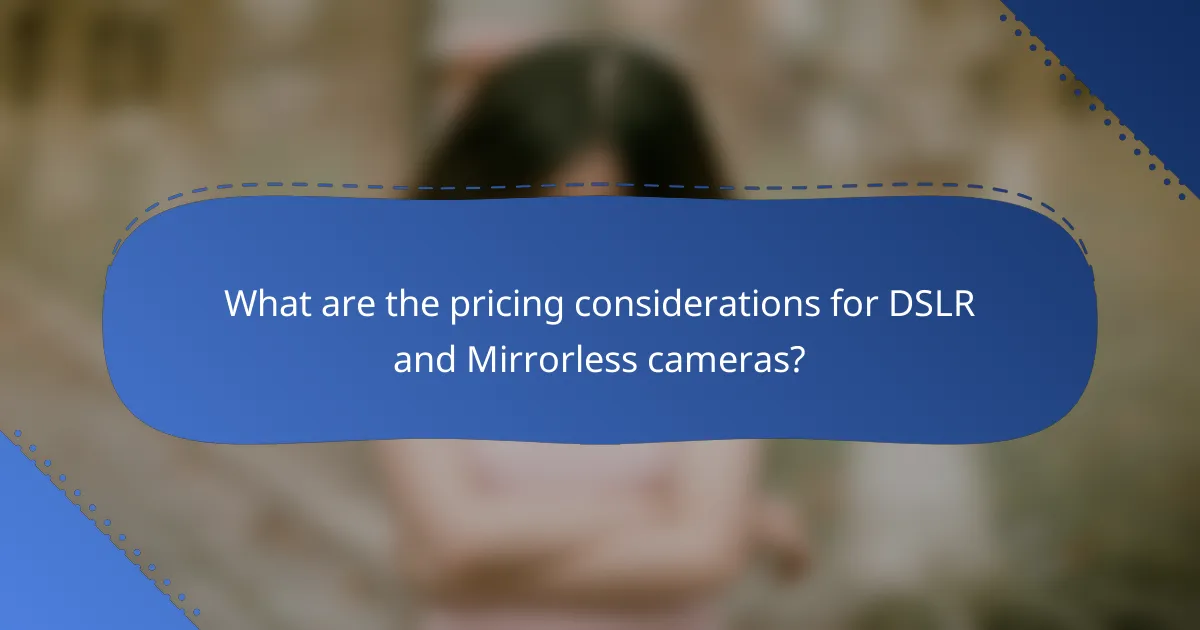When deciding between DSLR and mirrorless cameras, it’s essential to consider your photography needs and preferences. DSLRs offer a user-friendly experience and are ideal for traditional photography, while mirrorless cameras provide a compact design and advanced features, making them increasingly popular among modern photographers. Understanding the strengths of each type can help you choose the right camera for your shooting style and conditions.

Which camera is better for beginners: DSLR or Mirrorless?
For beginners, DSLRs are often considered better due to their user-friendly interfaces and extensive resources available for learning. However, mirrorless cameras are gaining popularity for their compact design and advanced features, making them a strong contender as well.
DSLR cameras offer user-friendly interfaces
DSLRs typically feature intuitive controls and a more traditional layout, which can be easier for beginners to navigate. The optical viewfinder provides a direct view of the scene, making it simple to frame shots without delay.
Many DSLRs also come with built-in guides and tutorials, helping new users understand camera settings and photography basics. This can significantly reduce the learning curve for those just starting out.
Mirrorless cameras provide lightweight options
Mirrorless cameras are generally lighter and more compact than DSLRs, making them easier to carry for extended periods. This portability is particularly beneficial for beginners who may not yet have the stamina for heavier equipment.
Additionally, the smaller size of mirrorless systems often allows for more discreet photography, which can be advantageous in candid or street photography situations.
DSLRs have extensive lens selections
One of the key advantages of DSLRs is their wide range of available lenses, catering to various photography styles. From wide-angle to telephoto, beginners can easily find lenses that suit their needs.
Moreover, many lens options are compatible with older DSLR models, providing a cost-effective way to expand a beginner’s kit without needing to invest in new equipment.
Mirrorless systems have faster autofocus
Mirrorless cameras often feature superior autofocus systems, utilizing on-sensor phase detection for quicker and more accurate focusing. This can be particularly useful for capturing fast-moving subjects or shooting in low-light conditions.
As technology advances, many mirrorless models now offer real-time tracking and face detection, making it easier for beginners to achieve sharp images without extensive technical knowledge.

When should you choose a DSLR camera?
Choose a DSLR camera when you prioritize traditional photography techniques, extended battery life, and the optical viewfinder experience. These features make DSLRs particularly suitable for specific shooting conditions and styles.
Best for traditional photography styles
DSLR cameras are often favored for traditional photography styles due to their robust build and familiarity among photographers. They typically offer a wide range of lenses and accessories, making them versatile for various genres like portrait, landscape, and wildlife photography.
Many photographers appreciate the tactile feel of a DSLR, which can enhance the shooting experience. The mechanical shutter and optical viewfinder provide a direct connection to the scene, allowing for precise framing and composition.
Ideal for long battery life
DSLR cameras generally have longer battery life compared to mirrorless models, making them ideal for extended shoots. A typical DSLR can last several hundred to over a thousand shots on a single charge, depending on usage and settings.
This extended battery performance is particularly beneficial for events like weddings or long outdoor sessions where charging options may be limited. Carrying extra batteries is less of a concern with DSLRs due to their efficiency.
Preferred for optical viewfinder experience
The optical viewfinder in a DSLR provides a real-time, lag-free view of the scene, which many photographers prefer. This feature allows for immediate feedback without the delay that can occur in electronic viewfinders.
Additionally, the optical viewfinder is unaffected by battery life, allowing you to compose shots even when the battery is low. This reliability can be crucial in dynamic shooting environments where every moment counts.

When should you choose a Mirrorless camera?
Choose a mirrorless camera when you prioritize compactness, advanced features, and video capabilities. These cameras are often lighter and more versatile than traditional DSLRs, making them ideal for various shooting scenarios.
Great for travel and portability
Mirrorless cameras are typically smaller and lighter than DSLRs, making them an excellent choice for travel. Their compact design allows for easy packing and handling, especially during long trips or hikes.
When selecting a mirrorless camera for travel, consider models with interchangeable lenses that don’t add significant weight. This way, you can adapt to different shooting conditions without compromising on portability.
Excellent for video recording
Mirrorless cameras often excel in video recording due to their advanced autofocus systems and superior video capabilities. Many models support 4K recording and have features like slow-motion and high frame rates, appealing to content creators.
For optimal video quality, look for cameras with in-body stabilization, which helps reduce shaky footage. This is particularly useful when shooting handheld or in dynamic environments.
Supports advanced features like in-body stabilization
Many mirrorless cameras come equipped with in-body stabilization, which compensates for camera shake during handheld shooting. This feature enhances image quality, especially in low-light conditions or when using longer focal lengths.
When choosing a mirrorless camera, check for additional advanced features such as high dynamic range and customizable settings. These can significantly improve your shooting experience and the quality of your images and videos.

What are the key differences between DSLR and Mirrorless cameras?
The main differences between DSLR and mirrorless cameras lie in their construction and functionality. DSLRs use a mirror mechanism to reflect light into an optical viewfinder, while mirrorless cameras forgo this system, allowing for a more compact design and often faster shooting speeds.
DSLRs use mirrors; mirrorless cameras do not
DSLRs operate with a mirror that flips up when taking a photo, directing light to an optical viewfinder. This mechanism can lead to a slight delay in shooting, especially in fast-paced situations. In contrast, mirrorless cameras capture images directly through the sensor, resulting in real-time electronic viewfinder feedback and typically quicker shutter response times.
The absence of a mirror in mirrorless cameras allows for a more streamlined design, which can be a significant advantage for travel and street photography where portability is essential.
Size and weight differences
Generally, mirrorless cameras are smaller and lighter than DSLRs due to the lack of a mirror and optical viewfinder. This can make them more appealing for photographers who prioritize mobility, such as those shooting in urban environments or on long hikes.
However, the size difference can vary significantly between models. High-end DSLRs may still be bulkier than entry-level mirrorless options, so it’s essential to compare specific models to find the best fit for your needs.
Performance in low light conditions
In low light situations, DSLRs often perform better due to their larger sensors and advanced autofocus systems. They typically excel in capturing detail and reducing noise, making them suitable for night photography or indoor events.
Mirrorless cameras have improved significantly in low light performance, but they may still struggle with autofocus speed in dim conditions. When choosing between the two, consider your typical shooting environments and whether low light capability is a priority for your photography style.

What are the pricing considerations for DSLR and Mirrorless cameras?
Pricing for DSLR and mirrorless cameras varies significantly based on features, brand, and market trends. Generally, entry-level DSLRs tend to be more affordable, while mirrorless options can range from budget-friendly to high-end professional models.
Entry-level DSLR prices
Entry-level DSLR cameras typically range from around $400 to $800 USD. These models often include basic features suitable for beginners, such as automatic settings and lightweight designs.
When considering an entry-level DSLR, look for bundled kits that include a lens, as this can provide better value. Popular brands like Canon and Nikon often offer models in this price range, making them accessible for new photographers.
